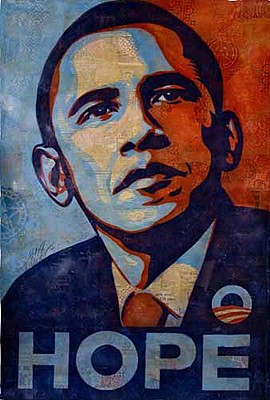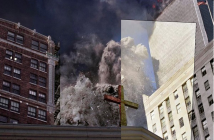OBAMA AND THE ARTS
During the heat of the election, and now in the interregnum period before the inauguration of President Obama, there has been a lot of talk about the arts and what policies the new president will enact. On a number of levels, this has been an important and much-needed discussion, because it has been a long time since this country had any serious debate about arts policy. Cultural conservatives, having decried a handful of controversial works in the 1980s, had diminished the National Endowment for the Arts (NEA) and generally offered little or no arts policies, certainly nothing coherent. As Thor Steingraber pointed out the in The Boston Globe a little while back: "A tax deduction is not an arts policy."
The Obama plan, as presented during his campaign, contains a broad set of goals that are intended to support the arts on a number of levels. Education, cultural institutions, the NEA, and tax fairness are all covered in the plan, with Education most prominent and thoroughly addressed. I think it is very important that education is at the top of the list, and the future of the arts in this country depends on it.
Often, when the idea of arts education is discussed, it is perceived as teaching children to make art. While this is certainly a part of it, the aspect of the Obama plan that is the most exciting is the expansion of art education to a broader group and covering a wider selection of topics. Art education is about more than teaching kids to paint, it is about teaching a love and respect for culture. Learning how to understand the arts, and place them in a larger context, is how audiences are built and cultures grow. Art education should be about far more than creating, it should build a whole new generation of artists, collectors, curators. It should also build a general public that is engaged with, inspired by, and supportive of the arts.
Before taking on the topic of education, though, there are some other needs made extremely pressing by the current economic meltdown. These include shoring up the institutions and markets in which art can thrive. This past week, David A. Ross (former director of Boston's ICA and SFMOMA) offers "The ten first steps that Barack Obama could take to renew the arts" in The Art Newspaper. The first eight of his points are addressed, to some degree or another, in the Obama plan. These include tax incentives, aWPA-style Artists Corps, more investment in the NEA, and cultural diplomacy. Ross is completely correct that these need to be tackled early and aggressively.
His last two points require a bit more consideration:
9. Establish either a cabinet-level Secretary for Art and Culture, or at the very least, create a White House arts advisory office to coordinate and show presidential support for American culture.
10. Create an emergency bailout fund for cultural institutions in dire need during this current credit crisis. At least $250m will be necessary, but this is a drop in the ocean when compared with the value these institutions return to the nation as a whole. This single act will affirm to all that the federal government will not stand by and allow these great resources to falter.
There has been a push for several weeks now to establish a Cabinet-level Secretary for Art and Culture, with musician Quincy Jones leading the charge and promoting an online petition. Certainly there is a groundswell of support for the idea, but what exactly would the job entail? Setting aside the obvious tasks of identifying and funding cultural projects, what type of advice would a Secretary of the Arts give the President? The Secretaries of State, the Treasury, the Interior, and the rest of the Cabinet have defined boundaries, roles and jobs. While I support the idea of a Secretary of the Arts, we need to have the job defined in a way that actually benefits artists and institutions, and improves the cultural and philosophical status of this country. Simply installing a Secretary who advocates for the same "arts" industries that are represented throughout government, like the film and music insdustries, corporate tax-shelter collections, and those who make money by exploiting the creativity of others, will not benefit the arts of the United States in any way. In fact, it would do the opposite, by further diminishing the voice and power of creatives to advocate for their needs, filtering the complexity of the conversation down to one Secretary and the goals of one administration.
Imagine, for example, that President Bush had a Secretary of the Arts. Would our cultural institutions have been better off? Would Bush, as a culturally conservative president, have been more inclined to increase NEA funding or arts education programs? Or, would his ideological inclinations demand that the Secretary use the power of their office to impose culturally conservative ideals on a number of agencies? We know this happened anyway, without the power of the Cabinet pushing for a rollback of the arts. The last eight years have seen politicization of government on all levels, so there is no reason to doubt that a Secretary of the Arts would have been influential in any of the ways that the creative sector would have wanted.
There is no reason to believe that a Secretary of the Arts in an Obama administration would not act in the best interests of all the cultural sectors, but what happens under the 45th president, the 46th, 47th? To create a position that powerful in government requires that we, the people, demand that the resposibilities of the job meet our needs and are not subject to random ideological shifts every four or eight years.
Finally, the idea of a bailout is intriguing, and free money never hurt any sector of the economy. With so many other groups asking for money, the arts should not hesitate to hold out the tin cup. Yet, like the idea of the Secretary, what would this bailout actually look like? Who would get the money?
Ross mentions "cultural institutions" as the obvious recipients, but who are these vague institutions? If the Obama team takes up the challenge of a bailout, one would hope for a more complex approach than an art-world version of Reagan's "trickle down" theory. Pouring money into museums, for example, will be great for their programs but very little of that money will reach artists. Instead, they would be wise to ensure that a portion of the bailout money to be dedicated to grant programs, tax incentives to offset the cost of housing and studio space, support for smaller venues whose budgets (and budget flexibility) are battered by the economic crisis, and other "grassroots-level" support. Increasing the amount of money in the pockets of those who are most likely to spend it and put it back into the system is a proven, New Deal method of stimulating the economy. Giving money to wealthy institutions who will, in turn, use it to buy art or resources from other wealthy institutions, does little but keep wealth concentrated among those who already have it.
It should be noted that there is already a draft of the American Recovery and Reinvestment Act of 2009 under discussion. The section concerning the NEA is short, but it covers the issue of getting money to artists in their studios, at least in that roundabout way that these bills address anything. The resolution calls for $50M to be "distributed in direct grants to fund arts projects and activities which preserve jobs in the non-profit arts sector threatened by declines in philanthropic and other support during the current economic downturn: Provided, That 40 percent of such funds shall be distributed to State arts agencies and regional arts organizations in a manner similar to the agency’s current practice and 60 percent of such funds shall be for competitively selected arts projects and activities [...]". It remains to be seen whether the 60 percent allocated to directly fund artist projects will remain intact, but it is encouraging that lawmakers acknowledge the need for street-level support and are pushing the NEA into action on that level.
The very fact that Mr. Obama's team has been talking so publicly about the arts is encouraging. The push for a new Secretary of the Arts, the idea of an arts bailout, and much of the other dialogue around art inspired by the new administration -- these are all signs of the hope for change that Obama promised. Now, when it comes time to implement the changes and turn hope into action, we must make sure to encourage responsible and considered plans that actually improve the lives of artists and those who engage on a daily basis with the arts. Like all economies, the arts are a living and breathing embodiment of this country, with rich and poor, young and old, weak and powerful all intertwined and fighting for what they believe in. This economic crisis is complex, and calls for complex solutions that have a lasting impact far into the future. As exciting as it is to have a president willing to listen to, and act on, the needs of the arts community, we must be bold and forward-thinking. We have four (and hopefully eight) years to work with Mr. Obama to make the change we need, let's make it meaningful as well.
- Shepard Fairey, Obama Hope, 2008.
Image via the Institute of Contemporary Art website, from the current survey exhibition of work by Shepard Fairey.




